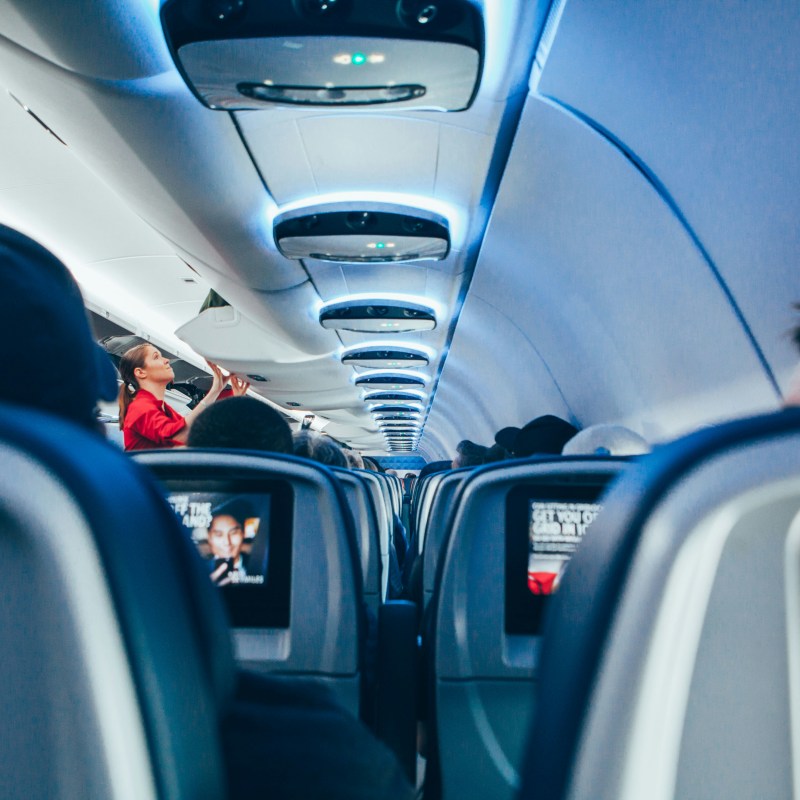
What began as an oddball trend on TikTok has taken off worldwide. Welcome to the era of rawdogging flights.
Videos by TravelAwaits
Over the last months, tales of minimalist flyers have popped up on just about every travel publication. But what does it mean to rawdog a flight?
Let’s get this out of the way first—yes, the term originated as dirty talk.
Despite its naughty origins, this term is used to describe a rejection of in-flight amenities. (If you’re curious, this is the TikTok video that started it all.)
Those rawdogging flights aren’t watching movies or TV shows, listening to music, reading books, journaling—or even drinking water and eating snacks. The goal is to remove absolutely any entertainment from the trip, along with food and water in most cases.
So, what are they doing instead?
These flyers are usually staring off into space like an air-bound monk. Some might watch the in-flight map, including celebs like Norway’s Erling Haaland—but even that’s not pure enough for some.
The big question… why?
Why are people rawdogging flights?
As someone who regularly writes about how to make red-eyes more comfortable, how to avoid tummy aches at 35,000 feet, and how to get free flight upgrades, the idea of purposefully making a flight uncomfortable is baffling.
What could compel someone to remove the only filaments of comfort offered to them?
If I had to summarize, I’d say it’s an experiment in asceticism and mindfulness. What began as yet another innocuous social media trend took off because flyers were interested in pushing themselves.
So, the easiest rationale is to demonstrate mental toughness.
Some also say that rawdogging flights is about reclaiming mental space in an era of constant stimulation. Others posit that it’s about making an anti-consumerist statement about immediate gratification. The spare few say that it’s a nostalgic callback to the early days of air travel.
Then, of course, there’s the allure of rawdogging flights for social media clout.
Here’s the more important question, in my opinion: Is it good for you?
Is it really unhealthy?
Dehydration is a serious issue for flyers. It’s why doctors recommend avoiding alcohol and caffeine during flights—and even before boarding.
Plane-born dehydration can exacerbate issues like jet lag and energy levels.
Flyers who avoid food and water make it difficult for their bodies to adjust to a new time zone and other conditions, whether a drier climate or higher altitude. They also put themselves at a higher risk of headaches, fatigue, and even dizziness.
Some people who are rawdogging flights even avoid movement at all costs.
Doctors recommend that flyers stand up and move around to improve circulation. Those with poor blood flow might experience discomfort and swelling during the flight.
While avoiding in-flight entertainment isn’t a health risk, avoiding food, water, and movement can create discomfort and even longer-lasting symptoms that follow you for the rest of your trip.
Is it beneficial?
Clearly, there are certain ways in which rawdogging flights is detrimental to health.
But let’s not lose focus of what’s driving this trend: An interest in ‘logging off’.
From a physical perspective, rawdogging isn’t good for you. But in a more mental realm, it’s not hard to see why this idea is appealing.
First, it offers flyers the chance to be mindful of their bodies and thoughts. It’s basically turning a flight into an extended meditation.
And meditation, unsurprisingly, benefits the mind in a variety of ways—and even the body.
Beyond the scope of meditation, rawdogging flights also allows travelers to get offline—similar to a ‘digital detox’. By avoiding screens of all shapes and sizes, they’re curating a more peaceful in-flight experience. Theoretically, at least.
Here’s my final conclusion on rawdogging flights: There are better places to practice mindfulness—ones that don’t include the risk of developing deep-vein thrombosis.
